Sea Trout Fishing Tackle
Essential equipment for sea trout night
fishing
|
|
As we have seen in the earlier pages, a sea
trout rod will, on occasion, be required to cast fairly
large and/or heavy flies. Such flies cannot be cast easily
on a light line. In addition, our sea trout rod may be
called upon to cope with very strong fish, so it should be a
fairly strong rod. For general sea trout fishing, I would
recommend a rod of ten feet in length, rated for a number 7
or 8 line, and with a through action, as opposed to a tip
action. Such a rod, which bends progressively throughout its
length, will allow the weight of the line to be felt more
easily when casting at night, when we must rely solely on
feeling. For nearly thirty years, I have used a rod built on a ten
and a half foot Bruce and Walker Multitrout blank, (since
shortened at the butt to ten feet, plus a two inch cork butt
extension) rated 6/7. It is probably still my favourite sea
trout rod. I also use a rod built on a Harrison 10 1/2 ft 3
piece blank rated 6/7. Both of these rods have a
smooth, through action. I use them with a number 8 line. On smaller rivers, or where deep wading is not required, a nine
and a half foot rod might be considered.
Most keen sea trout fishers will be familiar
with Hugh Falkus's recommendation of having a range of
line densities for varying conditions and times, a floating
line for early in the night, particularly in low water
conditions, with the option of additional lines with
different sinking rates for high water or when the sea trout
have "gone down" late in the night. Indeed, he recommended
setting up two rods for the night, one with a floating line
and the other with a sinking line, so that he could switch
between the two, fishing a variety of flies and lures -
singles, sunk lures, surface lures - according to conditions
as they changed throughout the night. This is a good option,
particularly if you have a pool or two to yourself for the
night and don't plan on moving about too much. Specific
requirements will be determined by the characteristics of
the river but, on the rivers I have fished, I would say that
about eighty percent of my fishing is done with a floating
line, a number 8 line, either double tapered or weight
forward. An
intermediate line or line with a sink tip is useful when the
river is running slightly high or for later in the night
when temperatures fall. I rarely now use a full sinker,
although I acknowledge that this omission may, on occasion,
cost me the chance of a fish. In general, I will feel fairly
well equipped if I arrive on a sea trout river with a
floating line and an intermediate line, plus a few sink tips
in a variety of lengths and densities, cut from a few mill
end lines. I like the simple practicality of the double
taper. I find it pleasant to handle, less liable to tangle
on bankside vegetation, and its use allows variable lengths
of line to be lifted from the water and recast with no need
for a false cast. I should say, however, that many
experienced sea trout fishermen prefer weight forward lines,
and the standard choice for many is an intermediate rather
than a floating line. Indeed, in recent seasons I myself
have been using a Barrio GT90 WF8 floating line, which
matches my ageing rods very well. The GT90 has a long and
very gradual rear taper behind the line belly,
which allows a longer length of line to be
aerialised than with a standard short bellied weight forward
line, while the slightly larger diameter of the running line
towards the front of the rear taper makes for pleasant
handling when retrieving but, at the same time, shoots more
easily than the thicker belly of the double tapered line. In
short, the GT90 offers the handling properties of the double
taper with the line shooting capability of the weight
forward line. It is a very easy line to fish comfortably at
distances of up to 23 yards, measured from reel to fly, i.e.
a standard cast (on a medium to large river) would see me
retrieving 5 yards of shooting line, leaving
3
yards of fly line between right hand and rod tip, with a
further
12 yards of fly line and 3 yards of leader outside the rod
tip. The next cast would then be made, with no false
casting, shooting the 5 yards of retrieved fly line and landing the fly at 23 yards across the river.
Although a further couple of yards might be extended if
necessary, very rarely would a cast
longer
than 23 yards be required at night.
How to Catch a
Sea Trout
|
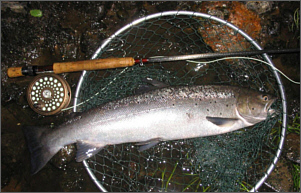 |
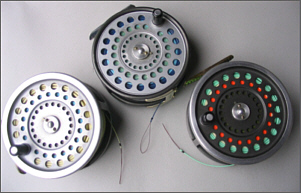 |
|
Sea Trout
Tackle |
Hardy
Reels |
The main requirement of a sea trout reel, for
me, is that it will hold a number eight
floating line (double tapered or weight forward) and a hundred yards of backing line. Such a
reel is likely to have a diameter of about three and three
quarter inches and a spool width of between 3/4 inch and one inch.
Excellent examples of such a sea trout reel are to be found
in the Hardy Marquis #10 and the Hardy St Aidan or, if you
can find one, a Hardy St John Mk 2 (or Mk 1 if you wind with
the right hand). The J. W. Young 1530 reel is also very good
(or Daiwa 809 or Shakespeare Beaulite in the same size, both
made by J. W. Young). To enable the faster retrieval
of line, many experienced sea trout fishers prefer a geared
"Multiplier" reel, such as the Hardy
Marquis 8/9 multiplier or the Young's 1500 series multiplier
or Shakespeare Speedex reel, all excellent sea trout reels
with diameters of about three and a half inches and with
enough capacity to hold a number eight line. Other reels
worthy of consideration might include the Sharpes Mentieth, which can be used in silent mode, always
useful for those who prefer the quiet approach. Of course,
there is a wide variety of rods and reels on the market
today (* see T&S review of sea trout rods), many of which
will do the job admirably, if no more efficiently than my
ageing favourites, good examples of which occasionally
appear on Ebay.
In fishing for sea trout at night, we will
often need to wade, sometimes quite deeply. At other times
we will be fishing with steep or heavily wooded banks behind. In such
circumstances, a net is essential, one that can be carried
comfortably and, when needed, brought into action quickly
and conveniently. It can be a folding net or one fixed on a
handle slung over one's back, as long as it can be operated
simply and reliably with one hand. For many years, I have
used a Gye net, made by Sharpes of Aberdeen and have found
it excellent.
|
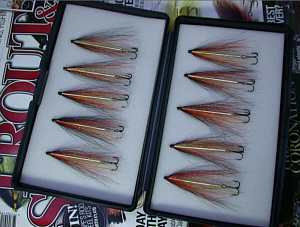 |
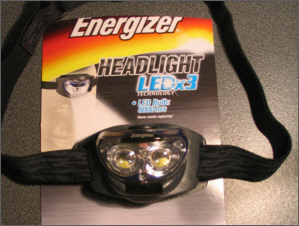 |
|
A Box of
Sea Trout Tube Flies |
A
Good Value Night Fishing Torch |
One final essential item of equipment for the
night fisherman is a good reliable, waterproof torch. It
should be emphasised here that the use of a torch on the
riverbank is generally frowned upon, particularly if shone
directly upon a sea trout pool. The use of a torch should be
kept to an absolute minimum, used only for essential tasks
like retying a cast or changing a fly. Some night fishermen
can manage even those operations by touch, without the need
for a torch. When the use of a torch is necessary, it is
best to come ashore and direct the torch beam well away from
the pool being fished. There is a good range of torches
available now which are suitable for night fishing. I have
for many years used a small Infinity Ultra LED torch hung
around my neck on a cord. Very recently, however, I spotted
a headlight, an Energiser Headlight LED X 3, on sale in B&Q
for just £7.99, which I just had to have. On getting it
home, I installed the three AAA batteries supplied and tried
it out. A simple switch gives two options ... a double white
LED or a single red LED. The white light is easily bright
enough to light an unfamiliar path to and from the river,
while the single red light is sufficiently bright to change
a fly, with minimal detriment to night vision. On trying it
out, I found the light very effective, easy to operate and
as comfortable as I imagine most headlights would be.
However, feeling that the light might become uncomfortable
after a few hours fixed on my head, especially if worn under
a hat, I tried it around my neck ... a bit like an
illuminated bow tie ... and found it very comfortable,
providing a perfect light for changing a fly, with the
option of slipping it up and around the head when walking.
With a stated 50 hours of continuous light between battery
changes, this seems like a very worthwhile purchase. |

Sea Trout Rods

Sea Trout Reels
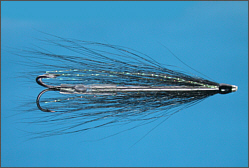
Sea Trout Needle Tube Fly
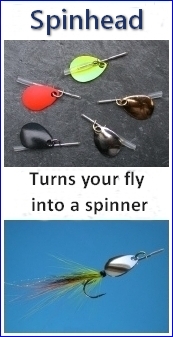
|